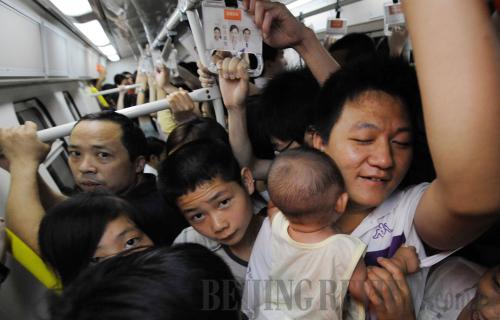|
 |
|
HARD TO BREATHE: A parent holding his baby tries to keep steady on a crowded subway car in Beijing. Public transport rides are far from comfortable for most commuters in the city (LI WEN) |
The strict traffic rules, backed up by the newly opened subway lines, have already proved effective in easing traffic congestion in Beijing, according to officials.
"On average, the duration of traffic jams has been reduced by more than two hours per day, from 3 hours and 55 minutes at the end of 2010 to the current 1 hour and 45 minutes," said BMCT Deputy Director Li Xiaosong on January 12.
Li's commission has unveiled an index system of Beijing's traffic congestion, the first for the city. According to the system, the 0-2 range signifies "smooth" traffic; 2-4, fairly smooth; 4-6, slightly congested, 6-8, moderately congested, and 8-10, heavily congested.
"For a long time before 2010, Beijing's congestion index had stood above 8.2, but it has remained at 6 since January 1," Li said.
However, the city government warns a string of new traffic measures are not enough to eliminate Beijing's gridlock once and for all.
Speaking at the annual session of the city's legislature on January 16, Beijing Mayor Guo Jinlong said soaring housing prices and traffic congestion were the major pests that harass Beijing's social and economic development.
He said easing congestion remained a pressing job in a city with 20 million people and 4.8 million vehicles, but vowed to effectively curb the problem in five years.
A challenge to all
While congestion used to be only reported in big cities, such as Beijing, Shanghai and Guangzhou in south China's Guangdong Province, smaller cities, such as Chengdu in southwestern Sichuan Province, Xi'an in northwestern Shaanxi Province and Nanjing in eastern Jiangsu Province, are also starting to feel the pain of chronic traffic jams.
Beijing's car-plate lottery is said to be a mutation of a similar measure in Shanghai, which introduced auctions of car plates for private use to limit car registrations in 1994. At the latest monthly auction, taking place on January 15, a license plate cost an average of 38,711 yuan ($5,865).
Since the inception of this auction scheme, residents in Shanghai have been complaining about the huge costs of owning a car and even questioned the legitimacy of the scheme. To avoid paying such a surcharge, some residents chose to register their cars in Shanghai's neighboring provinces.
According to a report on Beijing-based Legal Weekly, although some government officials in Shanghai also admitted the car plate auction is not a fundamental solution to traffic jams in the largest business hub of China, they said it did curb the growth of car sales. At the end of September 2010, Shanghai registered a total of 1.67 million cars, less than 40 percent of the figure in Beijing, which has a smaller population.
Although Shanghai's first subway line went into service in 1995, much later than 1971 in Beijing, the city's rail network has developed much faster. Shanghai now has the world's second longest metro system with a total length of 424 km. Its subway lines have already joined with the rail network in neighboring Jiangsu Province. According to its new rail system construction plan unveiled in October 2010, Shanghai will have more than 600 km of subway lines in operation by 2015.
At a symposium marking the 25th founding anniversary of the Shanghai City Comprehensive Transportation Planning Institute on December 23, 2010, an expert from the institute told Legal Weekly he believed Shanghai would not copy Beijing's practice of pulling cars off streets according to their license plate numbers.
The expert suggests Shanghai continue to prioritize the development of public transportation, further improve the city's infrastructure, establish an Internet-based traffic information release system and accelerate the transfer of functions of inner city areas to new areas.
| 